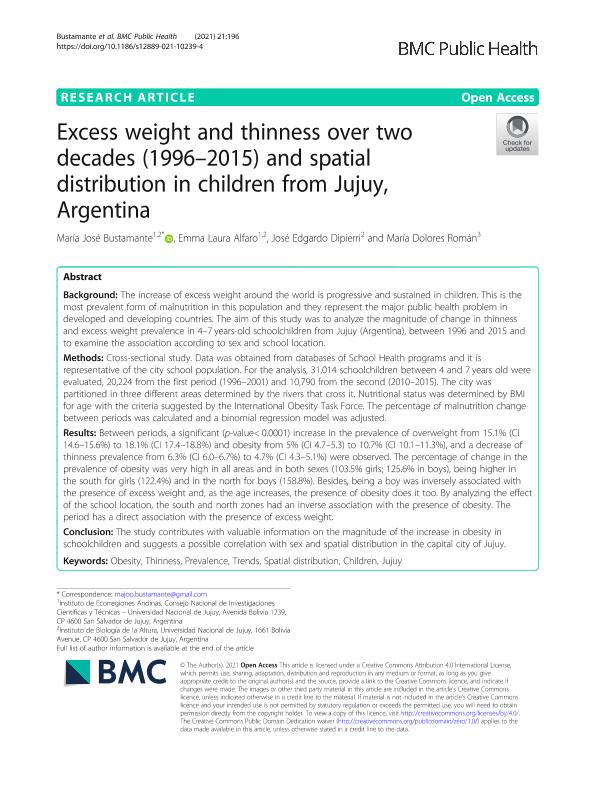Mostrar el registro sencillo del ítem
dc.contributor.author
Bustamante, María José

dc.contributor.author
Alfaro Gómez, Emma Laura

dc.contributor.author
Dipierri, Jose Edgardo

dc.contributor.author
Román, María Dolores

dc.date.available
2022-05-21T02:06:54Z
dc.date.issued
2021-12
dc.identifier.citation
Bustamante, María José; Alfaro Gómez, Emma Laura; Dipierri, Jose Edgardo; Román, María Dolores; Excess weight and thinness over two decades (1996–2015) and spatial distribution in children from Jujuy, Argentina; BioMed Central; BMC Public Health; 21; 196; 12-2021; 1-10
dc.identifier.issn
1471-2458
dc.identifier.uri
http://hdl.handle.net/11336/158011
dc.description.abstract
Background: The increase of excess weight around the world is progressive and sustained in children. This is the most prevalent form of malnutrition in this population and they represent the major public health problem in developed and developing countries. The aim of this study was to analyze the magnitude of change in thinness and excess weight prevalence in 4–7 years-old schoolchildren from Jujuy (Argentina), between 1996 and 2015 and to examine the association according to sex and school location. Methods: Cross-sectional study. Data was obtained from databases of School Health programs and it is representative of the city school population. For the analysis, 31,014 schoolchildren between 4 and 7 years old were evaluated, 20,224 from the first period (1996–2001) and 10,790 from the second (2010–2015). The city was partitioned in three different areas determined by the rivers that cross it. Nutritional status was determined by BMI for age with the criteria suggested by the International Obesity Task Force. The percentage of malnutrition change between periods was calculated and a binomial regression model was adjusted. Results: Between periods, a significant (p-value< 0.0001) increase in the prevalence of overweight from 15.1% (CI 14.6–15.6%) to 18.1% (CI 17.4–18.8%) and obesity from 5% (CI 4.7–5.3) to 10.7% (CI 10.1–11.3%), and a decrease of thinness prevalence from 6.3% (CI 6.0–6.7%) to 4.7% (CI 4.3–5.1%) were observed. The percentage of change in the prevalence of obesity was very high in all areas and in both sexes (103.5% girls; 125.6% in boys), being higher in the south for girls (122.4%) and in the north for boys (158.8%). Besides, being a boy was inversely associated with the presence of excess weight and, as the age increases, the presence of obesity does it too. By analyzing the effect of the school location, the south and north zones had an inverse association with the presence of obesity. The period has a direct association with the presence of excess weight. Conclusion: The study contributes with valuable information on the magnitude of the increase in obesity in schoolchildren and suggests a possible correlation with sex and spatial distribution in the capital city of Jujuy.
dc.format
application/pdf
dc.language.iso
eng
dc.publisher
BioMed Central

dc.rights
info:eu-repo/semantics/openAccess
dc.rights.uri
https://creativecommons.org/licenses/by-nc-sa/2.5/ar/
dc.subject
OBESITY
dc.subject
THINNESS
dc.subject
PREVALENCE
dc.subject
TRENDS
dc.subject
SPATIAL DISTRIBUTION
dc.subject
CHILDREN
dc.subject
JUJUY
dc.subject.classification
Epidemiología

dc.subject.classification
Ciencias de la Salud

dc.subject.classification
CIENCIAS MÉDICAS Y DE LA SALUD

dc.title
Excess weight and thinness over two decades (1996–2015) and spatial distribution in children from Jujuy, Argentina
dc.type
info:eu-repo/semantics/article
dc.type
info:ar-repo/semantics/artículo
dc.type
info:eu-repo/semantics/publishedVersion
dc.date.updated
2022-05-06T16:11:45Z
dc.journal.volume
21
dc.journal.number
196
dc.journal.pagination
1-10
dc.journal.pais
Reino Unido

dc.journal.ciudad
Londres
dc.description.fil
Fil: Bustamante, María José. Universidad Nacional de Jujuy. Instituto de Ecorregiones Andinas. Consejo Nacional de Investigaciones Científicas y Técnicas. Centro Científico Tecnológico Conicet - Salta. Instituto de Ecorregiones Andinas; Argentina. Universidad Nacional de Jujuy. Instituto de Biología de la Altura; Argentina
dc.description.fil
Fil: Alfaro Gómez, Emma Laura. Universidad Nacional de Jujuy. Instituto de Ecorregiones Andinas. Consejo Nacional de Investigaciones Científicas y Técnicas. Centro Científico Tecnológico Conicet - Salta. Instituto de Ecorregiones Andinas; Argentina. Universidad Nacional de Jujuy. Instituto de Biología de la Altura; Argentina
dc.description.fil
Fil: Dipierri, Jose Edgardo. Universidad Nacional de Jujuy. Instituto de Biología de la Altura; Argentina
dc.description.fil
Fil: Román, María Dolores. Universidad Nacional de Córdoba. Facultad de Medicina. Escuela de Nutrición; Argentina. Consejo Nacional de Investigaciones Científicas y Técnicas. Centro Científico Tecnológico Conicet - Córdoba; Argentina
dc.journal.title
BMC Public Health

dc.relation.alternativeid
info:eu-repo/semantics/altIdentifier/doi/http://dx.doi.org/10.1186/s12889-021-10239-4
dc.relation.alternativeid
info:eu-repo/semantics/altIdentifier/url/https://www.ncbi.nlm.nih.gov/pmc/articles/PMC7821675/pdf/12889_2021_Article_10239.pdf
dc.relation.alternativeid
info:eu-repo/semantics/altIdentifier/url/https://bmcpublichealth.biomedcentral.com/articles/10.1186/s12889-021-10239-4
Archivos asociados
